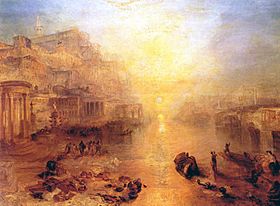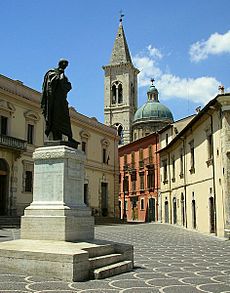Publius Ovidius Naso facts for kids
Quick facts for kids
Ovid
|
|
|---|---|
 |
|
| Born | Publius Ovidius Naso 20 March 43 BC Sulmo, Italy, Roman Republic |
| Died | 17 or 18 AD (age 59–61) Tomis, Scythia Minor, Roman Empire |
| Occupation | Poet |
| Genre | Elegy, epic, drama |
| Notable works | Metamorphoses |
Publius Ovidius Naso ( 20 March 43 BC – 17/18 AD), known in English as Ovid ( OV-id), was a Roman poet who lived during the reign of Augustus. He was a contemporary of the older Virgil and Horace, with whom he is often ranked as one of the three canonical poets of Latin literature. The Imperial scholar Quintilian considered him the last of the Latin love elegists. Although Ovid enjoyed enormous popularity during his lifetime, the emperor Augustus banished him to Tomis, a Dacian province on the Black Sea, where he remained a decade until his death.
Contents
Overview
A contemporary of the older poets Virgil and Horace, Ovid was the first major Roman poet to begin his career during Augustus's reign. Collectively, they are considered the three canonical poets of Latin literature. The Imperial scholar Quintilian described Ovid as the last of the Latin love elegists. He enjoyed enormous popularity during his lifetime, but the emperor Augustus banished him to a remote province on the Black Sea, where he remained until his death. Ovid himself attributes his exile to carmen et error ("a poem and a mistake"). His reluctance to disclose specifics has resulted in much speculation among scholars.
Today, Ovid is most famous for the Metamorphoses, a continuous mythological narrative in fifteen books written in the meter of epic. He is also known for works in elegiac couplets such as Ars Amatoria ("The Art of Love") and Fasti. His poetry was much imitated during Late Antiquity and the Middle Ages, and greatly influenced Western art and literature. The Metamorphoses remains one of the most important sources of classical mythology today.
Life
Ovid writes more about his own life than most other Roman poets. Information about his biography is drawn primarily from his poetry, especially Tristia 4.10, which gives a lengthy autobiographical account of his life. Other sources include Seneca the Elder and Quintilian.
Birth, early life, and marriage
Ovid was born in the Paelignian town of Sulmo (modern-day Sulmona, in the province of L'Aquila, Abruzzo), in an Apennine valley east of Rome, to an important equestrian family, the gens Ovidia, on 20 March 43 BC – a significant year in Roman politics. Along with his brother, who excelled at oratory, Ovid was educated in rhetoric in Rome under the teachers Arellius Fuscus and Porcius Latro.
His father wanted him to study rhetoric so that he might practice law. According to Seneca the Elder, Ovid tended to the emotional, not the argumentative pole of rhetoric. Following the death of his brother at 20 years of age, Ovid renounced law and travelled to Athens, Asia Minor, and Sicily. He held minor public posts, as one of the tresviri capitales, as a member of the Centumviral court and as one of the decemviri litibus iudicandis, but resigned to pursue poetry probably around 29–25 BC, a decision of which his father apparently disapproved.
Ovid's first recitation has been dated to around 25 BC, when he was eighteen. He was part of the circle centered on the esteemed patron Marcus Valerius Messalla Corvinus, and likewise seems to have been a friend of poets in the circle of Maecenas. In Trist. 4.10.41–54, Ovid mentions friendships with Macer, Propertius, Horace, Ponticus and Bassus. (He only barely met Virgil and Tibullus, a fellow member of Messalla's circle, whose elegies he admired greatly).
He married three times and had divorced twice by the time he was thirty. He had one daughter and grandchildren through her. His last wife was connected in some way to the influential gens Fabia and helped him during his exile in Tomis (now Constanța in Romania).
Literary success
Ovid spent the first 25 years of his literary career primarily writing poetry in elegiac meter. The chronology of these early works is not secure, but scholars have established tentative dates. His earliest extant work is thought to be the Heroides, letters of mythological heroines to their absent lovers, which may have been published in 19 BC, although the date is uncertain as it depends on a notice in Am. 2.18.19–26 that seems to describe the collection as an early published work.
The authenticity of some of these poems has been challenged, but this first edition probably contained the first 14 poems of the collection. The first five-book collection of the Amores, a series of poems addressed to a lover, Corinna, is thought to have been published in 16–15 BC; the surviving version, redacted to three books according to an epigram prefixed to the first book, is thought to have been published c. 8–3 BC. Between the publications of the two editions of the Amores can be dated the premiere of his tragedy Medea, which was admired in antiquity but is no longer extant.
Ovid's next poem, the Medicamina Faciei (a fragmentary work on women's beauty treatments), preceded the Ars Amatoria (the Art of Love), which has been dated to AD 2 (Books 1–2 would go back to 1 BC). Ovid may identify this work in his exile poetry as the carmen, or song, which was one cause of his banishment. The Ars Amatoria was followed by the Remedia Amoris in the same year. This corpus of elegiac poetry earned Ovid a place among the chief Roman elegists Gallus, Tibullus, and Propertius, of whom he saw himself as the fourth member.
By 8 AD, Ovid had completed Metamorphoses, his most ambitious work, a hexameter epic poem in 15 books. Here he catalogued encyclopedically transformations in Greek and Roman mythology, from the emergence of the cosmos to the apotheosis of Julius Caesar. The stories follow each other in the telling of human beings transformed to new bodies: trees, rocks, animals, flowers, constellations, etc. Simultaneously, he worked on the Fasti, a six-book poem in elegiac couplets on the theme of the calendar of Roman festivals and astronomy. The composition of this poem was interrupted by Ovid's exile, and it is thought that Ovid abandoned work on the piece in Tomis. It is probably in this period that the double letters (16–21) in the Heroides were composed, although there is some contention over their authorship.
Exile to Tomis
In AD 8, Ovid was banished to Tomis, on the Black Sea, by the exclusive intervention of the Emperor Augustus without any participation of the Senate or of any Roman judge. This event shaped all his following poetry. Ovid wrote that the reason for his exile was carmen et error – "a poem and a mistake", claiming that his crime was worse than murder, more harmful than poetry.
The Emperor's grandchildren, Julia the Younger and Agrippa Postumus (the latter adopted by him), were also banished around the same time. Julia's husband, Lucius Aemilius Paullus, was put to death for a conspiracy against Augustus, a conspiracy of which Ovid potentially knew.

In exile, Ovid wrote two poetry collections, Tristia and Epistulae ex Ponto, which illustrated his sadness and desolation. Being far from Rome, he had no access to libraries, and thus might have been forced to abandon his Fasti, a poem about the Roman calendar, of which only the first six books exist – January through June. He learned Sarmatian and Getae.
The five books of the elegiac Tristia, a series of poems expressing the poet's despair in exile and advocating his return to Rome, are dated to AD 9–12. The Ibis, an elegiac curse poem attacking an adversary at home, may also be dated to this period. The Epistulae ex Ponto, a series of letters to friends in Rome asking them to effect his return, are thought to be his last compositions, with the first three books published in AD 13 and the fourth book between AD 14 and 16. The exile poetry is particularly emotive and personal. In the Epistulae he claims friendship with the natives of Tomis (in the Tristia they are frightening barbarians) and to have written a poem in their language (Ex P. 4.13.19–20).
Yet he pined for Rome – and for his third wife, addressing many poems to her. Some are also to the Emperor Augustus, yet others are to himself, to friends in Rome, and sometimes to the poems themselves, expressing loneliness and hope of recall from banishment or exile.
The obscure causes of Ovid's exile have given rise to endless explanations from scholars. The medieval texts that mention the exile offer no credible explanations: their statements seem incorrect interpretations drawn from the works of Ovid. Ovid himself wrote many references to his offense, giving obscure or contradictory clues.
In 1923, scholar J. J. Hartman proposed a theory that is little considered among scholars of Latin civilization today: that Ovid was never exiled from Rome and that all of his exile works are the result of his fertile imagination. This theory was supported and rejected in the 1930s, especially by Dutch authors.
In 1985, a research paper by Fitton Brown advanced new arguments in support of Hartman's theory. Brown's article was followed by a series of supports and refutations in the short space of five years. Among the supporting reasons Brown presents are: Ovid's exile is only mentioned by his own work, except in "dubious" passages by Pliny the Elder and Statius, but no other author until the 4th century; that the author of Heroides was able to separate the poetic "I" of his own and real life; and that information on the geography of Tomis was already known by Virgil, by Herodotus and by Ovid himself in his Metamorphoses.
Most scholars, however, oppose these hypotheses. One of the main arguments of these scholars is that Ovid would not let his Fasti remain unfinished, mainly because this poem meant his consecration as an imperial poet.
Death
Ovid died at Tomis in AD 17 or 18. It is thought that the Fasti, which he spent time revising, were published posthumously.
See also
 In Spanish: Ovidio para niños
In Spanish: Ovidio para niños


